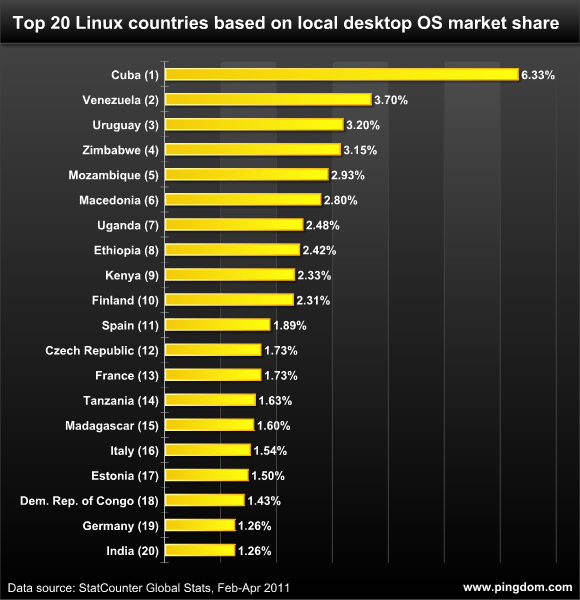 As a server OS, Linux has long been highly successful and a poster child for open source. For example, Linux currently powers a majority of the world’s web servers and supercomputers. As a desktop OS, however, Linux has yet to gain mainstream acceptance.
As a server OS, Linux has long been highly successful and a poster child for open source. For example, Linux currently powers a majority of the world’s web servers and supercomputers. As a desktop OS, however, Linux has yet to gain mainstream acceptance.
That said, there are some countries where people have embraced Linux on the desktop to a greater degree than most.
Since you probably wouldn’t be able to guess which these countries are no matter how hard you tried, we have highlighted them in this article. Read on to find out where desktop Linux is most popular, plus some nice bonus stats.
Top 20 countries by Linux market share
We looked at desktop OS market share, in this case defined as the share of computers used to access the Web. It’s basically the only metric out there that can give us an estimate of actual market share of actively used computers. The numbers are based on aggregated visitor stats for more than three million websites, courtesy of Statcounter.

This chart reflects the relative popularity of Linux as a desktop OS in each country. It doesn’t mean that these countries have the most Linux users overall (which is more difficult to estimate correctly).
A few general observations
As we collected the data for this article, we couldn’t help but make a few additional observations that you might find interesting.
- Linux is most definitely a niche OS on the desktop: In most countries, Linux has less than 1% market share.
- The Linux vs. Windows situation: In no country is Linux anywhere near replacing Windows on the desktop, but this shouldn’t come as a surprise.
- The absence of the US and UK: The United States is far outside the top 20, with a 0.73% desktop OS market share for Linux. This by the way happens to be the exact same market share as Linux has in the United Kingdom.
- The top countries in Europe are, in order: Macedonia, Finland, Spain, Czech Republic, France, Italy, Estonia and Germany.
Sweden, where we are based, sadly didn’t make this list. We just managed a measly 1.09% desktop OS market share for Linux, but at least that’s above average.
If you are wondering what Linux’s desktop OS market share is in the various world regions, here are the numbers:
- Worldwide, 0.76%
- Europe, 1.14%
- South America, 0.88%
- North America, 0.72%
- Oceania, 0.72%
- Africa, 0.45%
- Asia, 0.34%
In other words, Europe comes out as the overall most Linux-friendly world region.
Why these “low” numbers are not bad at all
Linux may currently be a niche desktop OS, but that doesn’t necessarily have to be a bad thing. It’s often described as the “tinkerer’s OS,” and it’s hard to see how it could go mainstream and retain that quality. If you keep that in mind, it’s quite possible that Linux will never go mainstream on the desktop, but will continue to flourish in a similar way it is now, with a relatively small but very dedicated community of users.
And when we say “relatively small” we really mean relatively. The worldwide Linux desktop OS market share (0.76%) coupled with the number of Internet users (1.97 billion) indicates that there are at least 15 million active desktop Linux users out there.
We say “at least,” because that number is probably significantly higher since there is a lot of overlap in these stats with people who use more than one OS and more than one computer.
That’s not a small community by anyone’s standards (except maybe Facebook’s 😉 ).
Notes about the data: The numbers are for the three-month period of February through April 2011 and are taken from StatCounter Global Stats. StatCounter bases those numbers on aggregated visitor stats for more than three million websites. To avoid statistical anomalies caused by small samples, we didn’t include any countries with fewer than 250,000 Internet users.



























